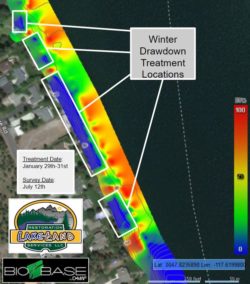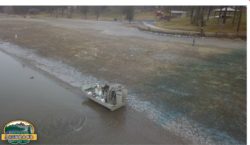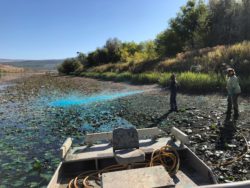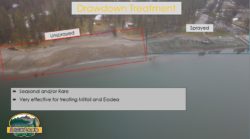by David Kluttz and Kendall Corn, Lakeland Restoration Services, LLC

BioBase analysis of fall/winter drawdown treatment using Imazapyr, 2,4-D, Triclopyr, and Flumioxazin. Blue areas have little to no vegetation, yellow has some vegetation, and red areas are matted with vegetation. This data was collected 6 ½ months after drawdown treatment.
With the introduction of flowering rush into aquatic systems in the Pacific Northwest, Lakeland Restoration began treating in spring and fall during the drawdown period to achieve aquatic invasive plant control. Imazapyr treatments were demonstrated to control as much as 80% of flowering rush sprouts when applied to moist soil before the water elevation was brought up. Another treatment window is during fall months after water elevation is lowered prior to winter.
Customers curious about the potential for controlling other invasive and/or nuisance plants contacted Lakeland requesting drawdown treatments. Imazapyr treatments alone controlled most plants except sago pondweed, curly leaf pondweed and leafy pondweed. Lakeland examined other aquatically labeled herbicides suitable for drawdown treatments. Triclopyr, 2,4-D, and Flumioxazin were identified as candidates for selective and general plant control in dewatered lakes.
Triclopyr and 2, 4-D provided selective control of Eurasian watermilfoil used in combination. Both products are systemic as well as soil-active. These products are also an effective control of fragrant waterlily and yellow floating heart applied in dewatered conditions.
Flumioxazin provides control of pondweeds, elodea and coontail where necessary. Along with products previously mentioned, this product is used in limited conditions where general weed control is desired (swimming areas, private property, docks, boat ramps, etc.). Flumioxazin can also be used as an algaecide that controls Nitella, Chara and planktonic algae.

Drawdown treatments can be conducted from an airboat along the shore, a truck or an ATV. If our airboat cannot reach a treatment site with a 600’ hose, our truck or ATV can be used. Sprayed areas are treated with a blue dye to ensure proper coverage of application and the spray dye allows homeowners to see that their property has been treated.
Using herbicide combinations and rotating products provides resistance management, preventing plant biotypes that may become immune to herbicides.
Several ecological advantages are evident when performing drawdown treatments:
- Products are typically not applied directly to water.
- Products are applied months before irrigation and recreational activities commence while the herbicides are tied up in the soil.
- Much less product is used during drawdown conditions. For example, when a combination of Flumioxazin, 2,4-D, and Triclopyr is selectively sprayed during drawdown, a fraction (less than 10%) of the product is used per acre vs. aquatic applications.
- Drawdown treatments reduce the amount of product introduced into an aquatic environment.
- Treating invasive and nuisance plants near boat ramps and loading areas reduces the amount of vegetation being transferred to other waterbodies on boat trailers.

Airboats allow our crew to disembark from the boat quickly and safely, as shown here during fragrant waterlily control using 2,4-D and Triclopyr.
This article describes field observation before and after treatments. Visual examination was conducted along with GIS and BioBase analysis of treatments.
In conclusion, drawdown treatments can be effective for general aquatic plant control as well as selective control of invasive plants. This article was written from general field conditions noted using aquatically registered products at label rates. More studies would be welcome.










